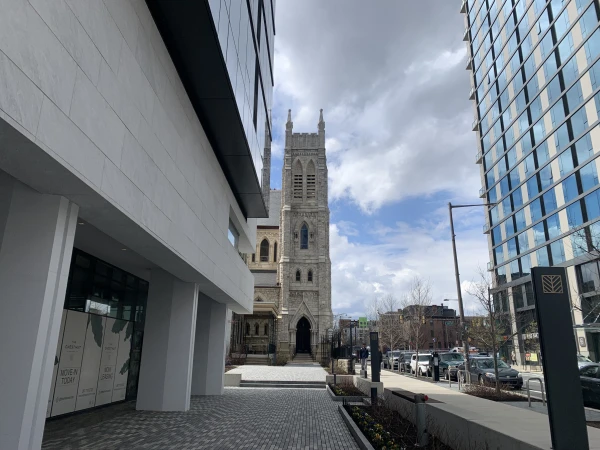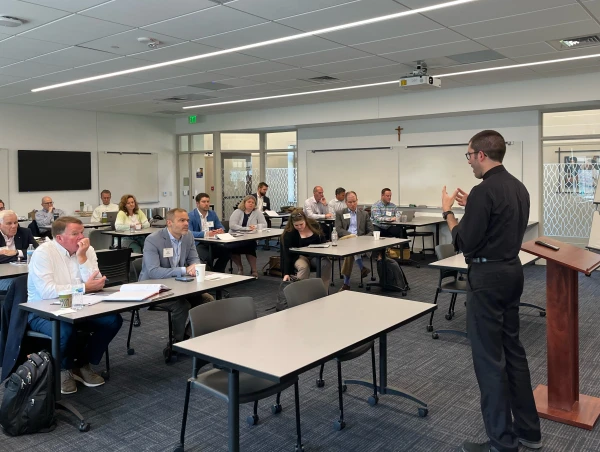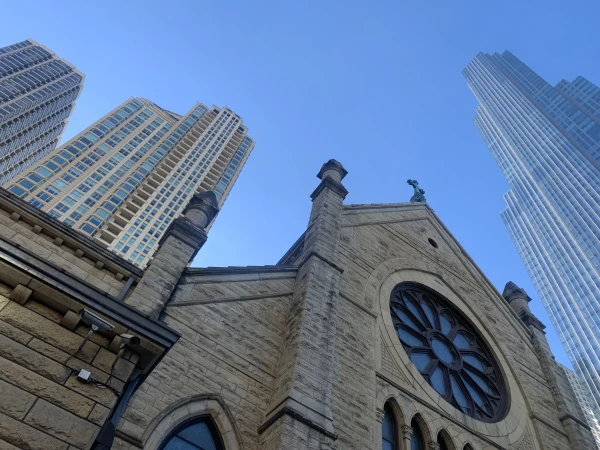CNA Staff, Aug 26, 2024 / 06:30 am
Los Angeles is one of the most expensive cities in the United States, with an average home price almost touching $1 million in 2024 — a landscape that crowds out not only the poor but also young families with children. The high cost of housing is one of the primary reasons why tens of thousands of people live on the streets of L.A., and most of those who are housed are “rent burdened,” which means they spend more than 30% of their income just keeping a roof over their heads.
In the face of such challenges, the Archdiocese of Los Angeles recently announced it will provide land for a new housing development dedicated to serving community college students and young people exiting the foster care system.
Amy Anderson, executive director of Our Lady Queen of Angels Housing Alliance and a former chief of housing for the City of Los Angeles, told EWTN News that a group of Catholic lay leaders from the business and philanthropic community reached out to the archdiocese with a vision for creating an independent, nonprofit affordable housing development organization.
“Our vision is to really collaborate with the archdiocese and [use] the resources potentially available from the archdiocese to create homes that are affordable to a wide range of populations and incomes,” Anderson told “EWTN News Nightly” anchor Tracy Sabol.
She said they hope to break ground on the project, known as the Willowbrook development, “about a year from now.”
“The archdiocese is a fantastic partner. They are providing the land for our first development, which is already in process, and we’re working really closely with them to identify additional opportunities.”
The proposed building, which will be located steps from Los Angeles Community College, will feature 74 affordable housing units as well as “on-site supportive services” for young people transitioning out of foster care — a population that often ends up experiencing homelessness.
The land, located at 4665 Willow Brook Ave. just a few miles from the Hollywood sign, currently hosts a Catholic Charities building, which will move its operations to another site to make way for the apartments.
“Through Catholic Charities and our ministries on Skid Row [an L.A. street where many unhoused people live] and elsewhere, we have been working for many years to provide shelter and services for our homeless brothers and sisters,” Archbishop José Gómez said in a statement to LAist.
“With this new initiative we see exciting possibilities to make more affordable housing available, especially for families and young people.”
Making land work for mission
The Catholic Church is often cited as the largest nongovernmental owner of land in the entire world, with an estimated 177 million acres owned by Catholic entities.
Maddy Johnson, program manager for the Church Properties Initiative (CPI) at the University of Notre Dame’s Fitzgerald Institute for Real Estate (FIRE), noted that the Church as a large landowner is not a new phenomenon, but there is a need today to adapt to modern challenges like regulations, zoning, and the importance of caring for the natural environment.
Many Catholic dioceses and religious orders have properties in their possession that aren’t fulfilling their original purpose, including disused natural land and parking lots as well as shuttered convents and schools. Sometimes, Johnson said, a diocese or religious order doesn’t even realize the full extent of what they own.
“How can the Church make good strategic decisions, strategic and mission-aligned decisions, if it doesn’t know what properties it’s responsible for?” she said.
(Story continues below)

Since real estate management is not the Church’s core competency, CPI aims to “provide a space for peer learning” to educate and equip Church leaders to make better use of their properties in service of the Church’s mission.
To this end, it offers classes within the undergraduate real estate minor at Notre Dame that aim to teach students how to help the Church make strategic real estate decisions that align with the Church’s mission. The Institute also organizes a quarterly networking call with diocesan real estate directors as well as an annual conference to allow Catholic leaders to convene, share best practices, and learn from one another.

In many cases, Catholic entities that have worked with CPI have been able to repurpose properties in a way that not only provides income for the Church but also fills a need in the community.
Johnson said the Church is called to respond to the modern problems society faces — one of which is a lack of housing options, especially for the poor.
“Throughout its history, there have been so many different iterations of how the Church expresses its mission … through education, health care — those are the ones that we’ve gotten really used to,” Johnson said.
“In our day and age, could it be the need for affordable housing? ... That’s a charitable human need in the area that’s not being met.”
Unlocking potential in California
Queen of Angels Housing’s first development, which has been in the works for several years, is being made possible now by a newly-passed state law in California that aims to make it easier for churches to repurpose their land into housing.
California’s SB 4, the Affordable Housing on Faith Lands Act, was signed into law in October 2023. It streamlines some of the trickiest parts of the process of turning Church-owned land into housing — the parts most people don’t really think about. These can include permitting and zoning restrictions, which restrict the types of buildings that can be built in a given area and can be difficult and time-consuming to overcome. The act even includes a provision allowing for denser housing on Church-owned property than the zoning ordinances would normally allow.
‘Yes in God’s Backyard’
The law coming to fruition in California is part of a larger movement informally dubbed “Yes in God’s Backyard,” or YIGBY — a riff on the term “Not in My Backyard” (NIMBY), a phenomenon whereby neighbors take issue with and oppose new developments.
Proponents of the YIGBY movement, which include the co-director of the Church Properties Initiative at Notre Dame, Father Patrick Reidy, believe the government should make it easier for churches of all denominations to create housing for those who need it.
Several Catholic real estate professionals with ties to California expressed excitement about the possibilities that SB 4 has created in the Golden State.
Steve Cameron, a Catholic real estate developer in Orange County, told CNA he is currently working with the Diocese of Orange, which abuts the L.A. Archdiocese, to inventory properties that could be repurposed for residential use.
He said their focus is on building apartment buildings and townhomes, primarily for rental rather than for sale, in an attempt to address the severe housing shortage and high costs in southern California.
Unlike some dioceses, the Orange Diocese has an electronic GIS (geographic information system) database showing all the properties it owns. Prepared by a civil engineering firm, the database includes details such as parcel numbers, acreage, title information, and demographic reports, which facilitate the planning and development process.
“Strategically, what we’re doing is we’re inventorying all of the property that the diocese and the parishes own and trying to understand where there might be underutilized property that would make sense to develop some residential use,” Cameron said.
Cameron said he can’t yet share details about the housing projects they’re working on but said they are looking to the Archdiocese of Los Angeles and the Queen of Angels housing project as a model for how to take advantage of the new incentives created by SB 4.
“I think it’s great, and it’s exciting that they’re taking the lead and that they are able to find an opportunistic way to repurpose an underutilized property to meet the housing shortage in California,” he said.
“[We] look at them as a role model for what we’re trying to accomplish here in the Diocese of Orange.”

John Meyer, a former president of the California-based Napa Institute who now works in real estate with J2 Development, emphasized the importance of viewing the Church’s vast real estate holdings as an asset rather than a liability.
Meyer said he is currently working with two Catholic entities on the East Coast on ground lease projects, one of which will fund the construction of a new Catholic student center at a university. He told CNA he often advises Catholic entities to lease the land they own rather than selling it, allowing the Church to maintain ownership of the property while generating income.
Naturally, he noted, any real estate project the Church undertakes ought to align with the Church’s mission of spreading the Gospel and not merely be a means of making money.
“Any time we look at the Church’s real estate decisions, it’s got to be intertwined with mission and values,” he said.
“We’re not just developing for the sake of developing. What we want to do is we want to create value for the Church, and we also want to create value for the community. So working closely with the municipality to make sure that needs are met, and to be a good neighbor, is important.”
He said Church leaders should strongly consider taking advantage of incentives in various states such as California for projects like affordable housing, which align with the Church’s mission and provide both social and financial benefits.
“Priests and bishops aren’t ordained to do these things, and sometimes they have people in their diocese that have these abilities, and sometimes they don’t,” Meyer said.
“This [new law] in California has created an incentive that we can take advantage of, so we need to take advantage of that incentive … it’s allowing us to unlock potential value in land while at the same time serving a social good that’s part of the mission of the Church.”





